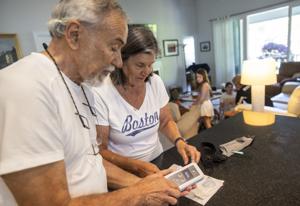MOUNT PLEASANT — For Dr. William Randazzo, the difference can be as simple as going out to eat without worry or just getting a good night's sleep. Having a new pump that can continuously provide small doses of his medication for Parkinson's disease smooths out the cycle of ups and downs taking pills once imposed on his life.
"At night, it was difficult to fall asleep or stay asleep," said Randazzo, a retired pediatrician. With the pump, he was able to sleep all night. The Food and Drug Administration approved the Parkinson's drug Vyalev in October 2024 to be administered around the clock with a through-the-skin pump, similar to the insulin pump diabetics use.

The new continuous administration system started to become available in December, and the Medical University of South Carolina has been able to get nine patients started on them so far, with another three or four pending, said Dr. Vanessa Hinson, director of the Parkinson's Foundation Center of Excellence at MUSC. Randazzo said there was an initial problem getting the pump because it is not yet covered by Medicare.
Parkinson's disease is caused by a progressive loss of neurons in the brain that produce dopamine, a neurotransmitter involved in movement, among other functions. Most Parkinson's drugs work to replace or mimic that dopamine. But taking pills to do that, as most Parkinson's patients do, presents a number of problems as the disease advances.
William Randazzo checks the medication pump for his Parkinson’s disease at his home Monday, April 14, 2025, in Mount Pleasant. Before having the device, he had to take his medicine every 2 to 3 hours and that it interfered with his sleep. Randazzo said he was taking 16 pills a day to help with his symptoms, and Hinson said it is not unusual for patients to take pills every few hours because the effect can wear off quickly.
"I saw somebody today who takes medicine every 21⁄2 hours because the medication becomes very short-acting," she said. Patients are also told not to take the medication with food, which can potentially interfere with its absorption. "That's easier said than done because, if you take medicine every 21⁄2 to three hours, when are you ever supposed to eat?" Hinson said.
"It becomes very complicated." Parkinson's patients also can frequently have slower emptying of the stomach, and because the medication is absorbed in the small intestine, that can further interfere with how well the drugs work, she said. In the morning, because he had not taken pills overnight as he slept, Randazzo said he might sit for 45 minutes or so before the medicine kicked in and he could begin to move into his day.
Probably the biggest drawback is the swing from the medications working and not working — which is sometimes described as "on" and "off" periods. When the drugs are off, patients can experience difficulties moving, stiffness and slowness, Hinson said. When the medication is working, it can also come with involuntary movements, twitching or jerking, she said.
Many people have witnessed these effects when watching interviews with actor Michael J. Fox, Hinson said, probably the most famous Parkinson's patient, who is also one of its foremost advocates and whose foundation has raised more than $1 billion for research. "So, it's a constant up-and-down, yo-yo effect," Hinson said.
That switch can also be unpredictable, which creates its own problems, particularly with walking, said Randazzo, who was diagnosed in 2016. William Randazzo walks to the backyard while working on his yard and playing with his grandkids at his home Monday, April 14, 2025, in Mount Pleasant. "So when you are going out, you get to the restaurant OK, you're able to eat," he said.
"Then when you're ready to get up, it's difficult. You walk with shaking, with a cane." Having the pump continuously deliver small doses of his medication addresses a lot of that, Randazzo said.
He can adjust it to a low, medium or high rate, depending on what he needs at the time. "At night, I put it on the low rate and I'm able to sleep fine through the night," Randazzo said. Hinson said Randazzo told her, "I feel like I haven't slept in years and now I do.
" The steady supply of dopamine "mimics what our brain is producing in the natural state," Hinson said, what the brain would do in someone without Parkinson's disease. There are, however, a few drawbacks to the pump system — the medication has to be refilled every 24 hours, and the pump site has to be moved every three days, which requires a new puncture, Randazzo said. Luckily for him, his wife, Glennis, is a nurse.
"It makes it much easier for me," he said. But even patients on their own have been able to handle it, Hinson said. The pump system comes with an applicator where patients push a button and it inserts the needle for them, so it is pretty straightforward, Hinson said.
"People have been managing that well," she said. Some people do get skin reactions at the injection site, and some might develop nodules under the skin, which might be irritating for patients, but so far it has been tolerated well, Hinson said. But as with all previous Parkinson's drugs, the pump system helps patients manage their symptoms and improve quality of life, but it is not a cure and will not change the course of their illness, she said.
"Medications cannot do that," Hinson said, "but exercise can." Those who regularly exercise, intensively for at least three days a week and for at least 30 minutes at a time, do see a slower progression, she said. That is one reason the Parkinson's Foundation holds Moving Day events around the country, to stress the importance for movement and exercise for those patients, and also to raise awareness and funding for services and research.
Penelope Celan, 6 (center), shoots the basketball with her grandmother Glennis Randazzo, sister Piper Celan, 10, and William Randazzo, Monday, April 14, 2025, in Mount Pleasant. Charleston's event will begin at 9:30 a.m.
April 26 at Edisto Hall in James Island County Park, 871 Riverland Drive. The event has a fundraising goal of $95,000 this year, and supporters are about halfway there so far, said Morgan Gilbert, development manager for the Carolinas chapter of the Parkinson's Foundation. The group covers every county in both states and provides community grants, programs, educational materials and other resources that are free to anyone who needs them, she said.
"Every single dollar stays right here in the Carolinas," Gilbert said. The foundation also pours millions into research for better treatment and a potential cure for the disease. But the event is also "to celebrate movement and encourage people to stay active," Gilbert said.
It is also to raise awareness because there may be people out there who are undiagnosed and don't recognize that their symptoms are actually signs of the disease, Hinson said. "Many people in our community think that slowing down and being a little shaky is part of normal aging, and it is not," she said. Getting diagnosed means getting people started on the right treatment and lifestyle changes that can make a difference for them, Hinson said.
.
Health

Parkinson's patients in South Carolina benefit from new pump for drugs and a push for exercise

Patients with advanced Parkinson's disease in South Carolina are often left at the mercy of the dozen or more pills they take to ease symptoms, leaving them on an uncertain path between "on" and "off" periods. A new drug pump...















